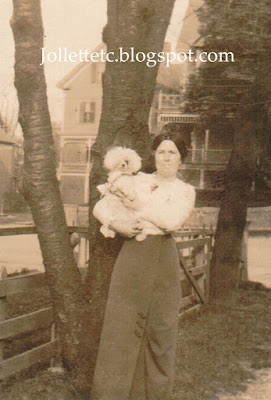Nothing beats conducting serious genealogy research in
your jammies. Late at night or on a cold rainy day, I love to hunker down at my
computer to see if the Library of Virginia has added anything new to its
digital collections, especially the Chancery Causes from county courts
throughout Virginia. Not all the cases have been digitized, but most of the
counties where my ancestors lived have their chancery causes online for all to
see. For free.
The search button allows visitors to search by plaintiff,
by defendant, by any surname mentioned in a case, and by county. What a
surprise when Madison County came online and there was a case involving a
Jollett. Specifically, the case was William Tate vs James Jollett, dated 1821.
Since Madison County is so close to Culpeper County, Orange County, and
Greene County where my known Jolletts were, surely this James Jollett had to be
mine too. Maybe he was even my 4X great-grandfather. One look at his answer to
the complaint, and I knew for sure I was correct. His signature is similar to
the signature on a petition he signed requesting the state to create a new
county for the convenience of citizens living too far from the Orange County
seat.
So what had Grandpa James Jollett done to land him in
chancery court?
William Tate's side of the story
According to William Tate, James Jollett sold him some
land in 1788 to which he did not have rights. Tate further elaborated that he
was made aware of a problem with the deed when two men named Churchill Blakey
and James Watson tried to obtain a patent on the same land. That led Tate to
enter a caveat, a legal notice that certain actions cannot be taken without
informing the caveator. Mounting a defense cost Tate about $25-$30, which
equates to roughly $537-$644 today. And he wanted Jollett to pay.
 |
| from Tate's complaint dated 28 Sep 1820 Madison County, VA 1821-009 |
To
the County Court of Madison sitting in Chancery. Your orator William Tate,
humbly showeth to the Court that sometime in the year 1788 he purchased a tract
of land of one James Jollett who assured your orator that he had a good title
to the same, and being in possession of a deed which he called a title deed he
assigned the same viz to your orator, & this was the only written
conveyance which s[aid] Jollett made to your orator, & put him in
possession of the land & for the purchase money thereof your orator
executed his note to s[ai]d Jollett for the payment of the purchase money to
the amt. of £11. Your orator further says that the s[ai]d Jollett has no title
to the same,
James Jollett's side of the story
James
Jollett was not quick to respond - it took 8 months! - but finally he did
respond. Jollett said that in fact, Tate never finished paying him but had taken
possession of the land just the same. Because he was aware of Tate’s caveat and
suit against Blakey and Watson, Jollett had delayed suing Tate for the balance.
As he pointed out, Tate won that suit by proving he had a clear title. Shortly
thereafter, Tate sold the land to Linn Banks and was paid four times what he
himself had paid Jollett. Now all Jollett wanted was for the case to be
dissolved and for Tate to pay his costs “most unjustly expended.” Jollett's lawyer argued most eloquently:
 |
| from Jollett's response dated 10 May 1821 Madison County, VA 1821-009 |
How
is it possible then that this Court can pretend to arrest the judgment which
this respondent has obtained against s[ai]d Tate? Is not the title of the land
good which this respondent sold to s[ai]d Tate? Has not s[ai]d Tate sold this
identical land? And has he not received the full amount of the purchase money
for the same? All of these interrogations must be answered affirmatively. The
complainant sets up a flimsy pretext in his Bill upon the subject of the costs,
which he paid in the prosecution of his suit against Watson & Blakey,
whatever he may of paid by argument or otherwise this respondent [continued on next page: cannot be
responsible for the same]
It did not take long for the Court to find in favor of
Jollett. Tate was required to pay James Jollett £22, plus 5% yearly from
October 15, 1788, plus court costs and Sheriff’s commission until paid up. He
was given credit for having paid £11 at the initial sale.
It took Tate four years to satisfy the Court at which
time the injunction was dissolved on November 25, 1824, and finally dismissed
with court costs February 24, 1825. Justice is not swift.
Nevertheless, it is good news that my ancestor was on the
right side of the law. However, as interesting as chancery causes might be, it is
not always good news to find a relative involved in a court case. Thanks to the
Chancery Causes available through the digital collections at the Library of
Virginia, I learned that a minister in my family was sued by a neighbor for
selling him a horse that was no good, that my 3X great-grandfather was sued for
non-payment of debt and later for fraud, and that the ugly details of a
great-grandaunt’s divorce case are there for everyone to see.
As they say, “Be careful what you wish for!”
Amy Johnson Crow continues to challenge genealogy
bloggers and non-bloggers alike to think about our ancestors and share a story
or photo about them. The challenge is “52 Ancestors in 52 Weeks.”
Wendy
© 2019, Wendy Mathias. All rights reserved.
















































